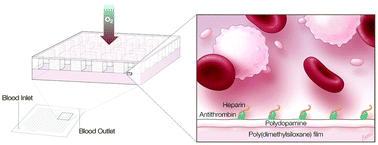Surface modification of poly(dimethylsiloxane) with a covalent antithrombin–heparin complex for the prevention of thrombosis: use of polydopamine as bonding agent
Abstract
A modified poly(dimethyl siloxane) (PDMS) material is under development for use in an extracorporeal microfluidic blood oxygenator designed as an artificial placenta to treat newborn infants suffering from severe respiratory insufficiency. To prevent thrombosis triggered by blood-material contact, an antithrombin–heparin (ATH) covalent complex was coated on PDMS surface using polydopamine (PDA) as a “bioglue”. Experiments using radiolabelled ATH showed that the ATH coating on PDA-modified PDMS remained substantially intact after incubation in plasma, 2% SDS solution, or whole blood over a three day period. The anticoagulant activity of the ATH-modified surfaces was also demonstrated: in contact with plasma the ATH-coated PDMS was shown to bind antithrombin (AT) selectively from plasma and to inhibit clotting factor Xa. It is concluded that modification of PDMS with polydopamine and ATH shows promise as a means of improving the blood compatibility of PDMS and hence of the oxygenator device.


 Please wait while we load your content...
Please wait while we load your content...